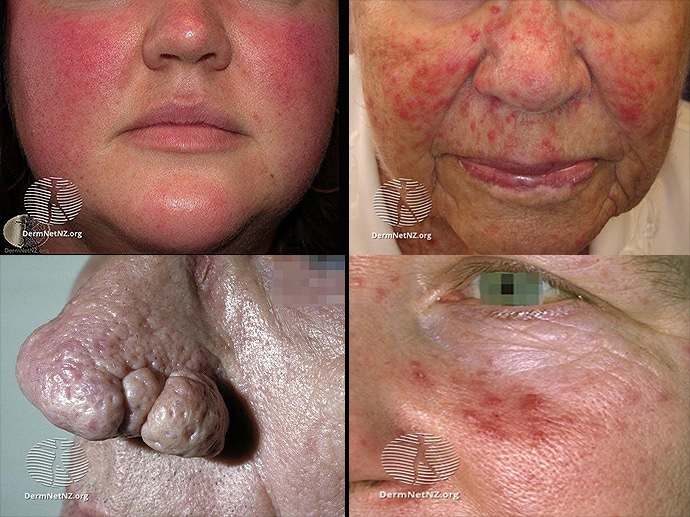Rosacea is a chronic inflammatory skin disease that centers on the pilosebaceous units and presents with at least one of the following features:
Centrofacial erythema with telangiectatic mats and flushing;
Inflammatory lesions (papules, pustules, cysts);
Phymatous changes (skin hypertrophy and fibrosis), usually affecting the nose; and/or
Ocular inflammation (conjunctivitis, blepharitis, chalazion).
The cardinal symptoms of rosacea are stinging, burning, and itching. The National Rosacea Society Expert Committee delineates four subtypes of rosacea—erythematotelangiectatic, papulopustular, phymatous, and ocular—although these patterns overlap in clinical practice[1,2] (Figure). Although rosacea classically presents during adulthood, there are rarer pediatric and granulomatous presentations.

Figure. The four rosacea subtypes. Top left: . Erythematotelangiectatic rosacea. Top right: Papulopustular rosacea. Bottom left: Phymatous rosacea. Bottom right: Ocular rosacea.
Rosacea affects all ethnicities, but light-skinned people of European descent are the most prone, with one Swedish study[3] showing a prevalence of 10% (women 14%, men 5%; 81% erythematotelangiectatic type, 19% papulopustular type). The global prevalence of rosacea is 5.41% in women and 3.9% in men, and the condition primarily affects adults between 45 and 60 years of age.[4]
Here are five things to know about rosacea.
1. It's Not Just a Skin Disease
Rosacea is associated with hyperreactivity of the innate immune system, which protects epithelial barriers against infection, and chemical or physical (eg, ultraviolet radiation, extreme heat or cold) injury. This primitive, nonspecific inflammatory network is triggered by a range of environmental, dietary, hormonal, and lifestyle factors.[5] In this broader context, rosacea may just be the superficial tip of an inflammatory iceberg.
Rosacea has a strong hereditary component, with recent genome-wide association studies showing a clustering of the genetic risk loci for rosacea, type 1 diabetes, celiac disease, rheumatoid arthritis, and multiples sclerosis.[6,7] Women with rosacea are more likely to have these autoimmune disorders, with increased odds ratios (ORs) of 2.59 for type 1 diabetes, 2.03 for celiac disease, 1.65 for multiple sclerosis, and 2.14 for rheumatoid arthritis; intriguingly, this same study showed a striking gender difference, with rosacea in men only increasing the prevalence of rheumatoid arthritis (OR, 2.05).[8]
Epidemiologic studies have linked rosacea to comorbid conditions affecting almost every organ system[4,8,9,10,11,12]:
Immune (dietary and airborne allergies);
Gastrointestinal (ulcerative colitis, Crohn disease, Helicobacter pylori infection, gastroesophageal reflux disease, celiac disease);
Cardiovascular (hypertension, coronary artery disease, dyslipidemia);
Endocrine (types 1 and 2 diabetes mellitus);
Musculoskeletal (rheumatoid arthritis);
Neurologic (migraine, dementia, Parkinson disease); and
Psychiatric (depression, anxiety, alcoholism).
Furthermore, many of these associations strengthen with rosacea severity.[13]
Should every patient with rosacea be screened for each of these illnesses? That would hardly be feasible, given the high prevalence of rosacea. But clinicians should consider targeted screening questions for individuals with rosacea who have additional risk factors for these comorbid conditions.
Medscape Dermatology © 2018 WebMD, LLC
Any views expressed above are the author's own and do not necessarily reflect the views of WebMD or Medscape.
Cite this: Rosacea: 5 Things to Know - Medscape - Sep 19, 2018.











Comments